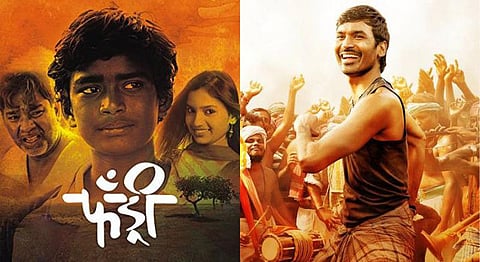
- HOMEGROWN WORLD
- #HGCREATORS
- #HGEXPLORE
- #HGVOICES
- #HGSHOP
- CAREERS
- ABOUT US
- CONTACT US

The term ‘Dalit’, as derived from the root ‘dal’ meaning to break or split, was coined by Jyotibha Phule, the founder of the Satya Shodhak Samaj. The term was and continues to be used to refer to victims of caste-based social segregation in the Indian society.
The daily experiences of the Dalit community are considered a normative social reality because of which it is often misrepresented or not represented at all in mainstream cinema.
Caste has now become a treasured token subject for the ‘savarna saviour’ trope in the Hindi film industry, where a Savarna character, unlike the rest of the community, believes that the marginalised deserve ‘rights’ and comes to the ‘rescue’ of Dalit individuals. The reality is not as simple, even when someone in the position to torment, sways away from their community and decides to not be a tyrant.
A lot of films from the Hindi film industry follow the trope; Ayan Ranjan in Article 15, Bhuwan in Lagaan, Mohan Bhargawa in Swades and so on. The question here is about the agency. Why does the mainstream cinema shy away from even attempting to put Dalit people at the forefront of their own struggles where they reach a position of power to resist and ‘rescue’ themselves. Karnan, directed by Mari Selvaraj, is an exceptional instance of regional cinema showing us that it can be done.
‘Dalit’ became a self-chosen term in 1972 when a group of Bombay youths, inspired by the American ‘Black Panthers, organised the ‘Dalit Panthers’ in an effort to unite and ignite revolution among the ‘lower caste’ communities. Most Dalit struggles have been taken up and led by the people of the community themselves — mainstream cinema, instead of attempting to get closer to representing a realistic picture, often ends up reinforcing stereotypes by taking the Brahminic saviour route.
The question is if mainstream cinema can put Savarna characters in lesser prominent roles in Dalit stories, where Dalit characters are not put in a position to look up to but just look at Savarna characters as facilitators of the resistance who are not trying to ‘rescue’ anyone or trying to make the struggle their own. Mainstream cinema, by reinforcing stereotypes and through misrepresentation often creates a vacuum where responses and resistance from Dalit characters are either limited or absent.
Though meant for the greater good, it all comes down to questioning the lack of layered representation and to put it point blank — questioning the lack of nuance.
Acknowledging that casteism still exists, attempting to portray the issue is important but is surface level sufficient? The Hindi film industry often markets a film as ‘anti-caste’ and for the greater good and when a film is marketed as ‘anti-caste’, both the caste and the community to which the ‘saviour’ character belongs inevitably becomes the focus of the film.
With regional cinema, even when the creators themselves are not labelling the films, critics are quick to label films representing Dalit identities and struggles as ‘Dalit Cinema’. One questions if there is a distinction between ‘anti- caste cinema’ and ‘Dalit cinema’ — do they both target a different audience?
Perhaps, ‘anti-caste cinema’ is a means of instant gratification, the saviour saves and the issue at hand gets resolved by the time credits roll and everyone can look the other way.
Regional cinema, on the other hand, provides a more realistic lens to Dalit struggles through films like Fandry, directed by Nagraj Manjule, where the practices and effects of the caste system are explored beyond the surface. In the case of Fandry, this is done through an adolescent Dalit boy in love with an upper caste girl. As life imitates itself on-screen, the violence surrounding caste in regional cinema is often accompanied by a striking silence. The caste-based violence as represented in regional cinema often has tones of normalcy to it, mimicking reality, unlike in mainstream cinema where the focus is often on acts of violence itself and not Dalit stories and struggles.
Regional cinema often represents Dalit narratives without commenting on them. Fandry is structured around the boy’s pursuit of love, his love happens to belong to an ‘upper’ caste. His struggles are explored through his aspirations and his aspirations are limited by his caste. Mainstream cinema on the other hand often tends to structure Dalit stories around the struggles and not stories. While the attempt is to divert attention towards the atrocities, the portrayal is counterproductive as it leaves out the scope for the community to have aspirations at all.
With films like Karnan and Fandry, regional cinema manages to do something the Hindi film industry constantly keeps itself away from; it explores the stories surrounding caste through the point of view of the characters most affected by it.
If you enjoyed reading this, we also suggest:
